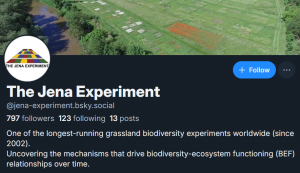Subproject 02: Chemical Interactions (1 PhD position)
Principle Investigators: Unsicker, Sybille, Kiel University; Weisser, Wolfgang, Technical University of Munich
Summary:
Plants constitutively release a large diversity of volatile organic compounds (VOC) from their organs. However, when attacked by e.g. herbivorous insects, VOCs are released at much higher concentrations and in greater diversity. Abiotic factors such as light, water availability, and temperature can also strongly influence plant VOC emission. In their natural environment, plants are often simultaneously exposed to abiotic and biotic stress, and this combined stress can lead to synergistic effects that cannot be predicted by individual stress events. To date, we know little about the stability of VOC emissions from individual plants and plant communities, and we don´t know whether the species-specific responses of plants to biotic and abiotic stresses lead to stabilization of VOC emissions at the community level when communities are more diverse, as predicted by the portfolio effect. Our previous results show that plant species richness effects the VOC emission of plant communities and plant individuals within those communities.
In this subproject, our main aim is to investigate whether plant diversity stabilises plant VOC emission as an important ecosystem function, both over time and during periods of resistance and recovery during and after an extreme climate event. We will use repeated measurements throughout the growing season to assess the temporal stability of plant VOC emission. In addition, we will measure VOC emission in response to an extreme climate event, i.e. a hot drought, in an Ecotron experiment.
Finally, we will test whether plant species richness can buffer the effects of combined biotic and abiotic stress on VOC emissions of individual plant species and plant communities in a microcosm experiment. Our measurements of VOC emission will also contribute to test the Research Unit´s main hypothesis that multifunctional stability is highest in high-diversity plots.
Available positions: 1 PhD student;
Job advertisement: Stellenausschreibung (PDF download)
Please send your application as a single pdf in English including a letter of motivation, summarizing your experience and future vision, CV of no more than 4 pages, list of publications and relevant certificates (degree certificates, etc.) and the names of two referees (including email address) to Prof. Dr. Sybille Unsicker sunsicker@bot.uni-kiel.de



